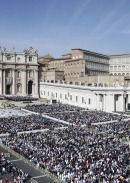Book Review: The rise and fall of a revolutionary
Article:
06.11.19
Book Review: The rise and fall of a revolutionary
Annibale Bugnini, Reformer of the Liturgy by Yves Chiron, Angelico Press, 200pp, £14.50
reviewed by James Tolhurst
This rather sad book tells the story of a farm boy, keen on ceremonies, but not a genius, who like his namesake achieved victory and then fell from grace.
Annibale Bugnini was fortunate in his contacts. Early on he made friends with Mgr. Montini and a whole host of liturgical experts: Martimort, Leclerq, Roguet, Pius Parsch et al. He said that “this was the beginning of my liturgical vocation.” He became director and later editor of Ephemerides Liturgicae in 1945 which then had only 64 subscribers (some consolation for magazine publishers) and began to outline his own plans for liturgical reform.
Trying out theories
In 1957 he became professor of pastoral liturgy at the Lateran University, at the same time trying out his theories in poor parishes in Rome. He set out his ideas in La Nostra Messa, but both the authorities “judged it was not opportune” yet he published it anyway at his own expense – it sold well. It was part of his vision to have a role for the lettore giving a commentary to explain the celebrant’s gestures and leading the congregation in their responses. Chiron adds “It was very bold on several points and did not respect all of the norms then in force”. Others would say that he was introducing what bishop Charrière of Lausanne called “a screen between the priest and the faithful,” to the disadvantage of both.
Revolutionary ardour
All the time, Bugnini was climbing the ecclesiastical ladder, becoming secretary of the Liturgical Commission, and with the encouragement of his friend, now Paul VI, increasingly involved with the preparation and implementation of Vatican II. His ability as an organizer began to be recognized but Chiron notes “the slightly abrupt tone which was to be his trademark”.
There was in Bugnini’s mind a certain revolutionary ardour which wanted to bring about reform despite opposition. He said, “The celebration in the language of the people is often done facing the assembly; this makes certain gestures seem anachronistic or superfluous … which, especially in certain circles, causes incomprehension and weariness.” One asks, to whom? Here we see what Archbishop Marini would calls Bugnini’s “singlemindedness, even stubbornness.” It would explain the sudden termination of his post at the Lateran.
He had to go
Even as he reached the pinnacle of achievement as Secretary for the Congregation of Divine Worship and Archbishop of Diocletiana in 1972 the signs were there. We now know that he set an impossible twenty-four hour deadline for the composition of Eucharistic Prayer II which was finished in the morning on the terrace at a café in Trastevere. The International Theological Commission put on record its concern about the numerous translations which were “great dangers to the unity and integrity of the Catholic faith.”
It was never the case that Bugnini was a secret freemason (pace Michael Davies), merely that he was seen as “excessive” – in other words, he had too many who were not his friends, rather like Thomas Cromwell, and so like him, he had to go. He was offered Uruguay and refused, so got Iran instead. He lamented “Oh! how rare true friends are … how rare it is in the Church. I hope to find more of it among the Muslims.” What he found was the Ayatollah. He would write his memoirs and a large tome on the history of the Church in Iran, but when he asked - having reached retirement age - to return to Italy, he was told that the Pope wished him to remain at his post. He died in 1982. His parents, naming him after the Carthaginian general, obviously had high hopes for him but maybe they chose to forget that at the end he took poison rather than surrender.
Notes:
Fr. James Tolhurst has been a parish priest and a seminary Spiritual Director andis a former Book Reviews Editor of Faith Magazine.





